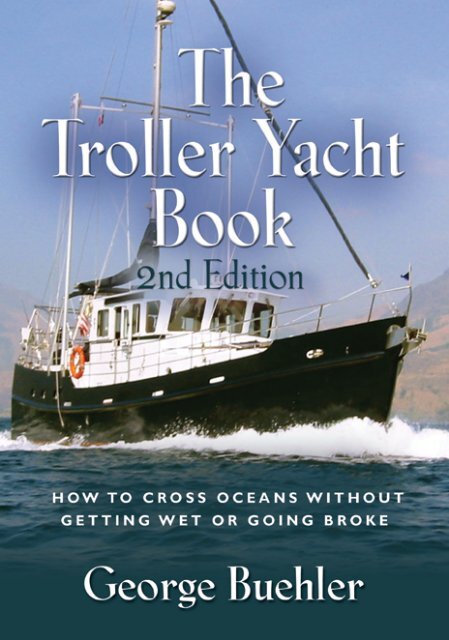The Troller Yacht Book, 2nd Edition - The Book Locker
The Troller Yacht Book, 2nd Edition - The Book Locker
The Troller Yacht Book, 2nd Edition - The Book Locker
Create successful ePaper yourself
Turn your PDF publications into a flip-book with our unique Google optimized e-Paper software.
This is the 21st century update of yacht designer George Buehler's popular <strong>The</strong><br />
<strong>Troller</strong> <strong>Yacht</strong> <strong>Book</strong>, the guide to fuel efficient and safe offshore cruising<br />
powerboats. Loaded with detailed information about cruising design theory,<br />
building, and outfitting, it is even more essential reading than the original<br />
edition for anyone thinking about ocean cruising in a powerboat. Buehler's<br />
attractive, affordable, rugged, and ultra-economical powerboat designs are<br />
popular, and are cruising all the world's oceans.<br />
<strong>The</strong> <strong>Troller</strong> <strong>Yacht</strong> <strong>Book</strong><br />
How to Cross Oceans Without Getting Wet or Going<br />
Broke<br />
Order the complete book from the publisher<br />
<strong>Book</strong>locker.com<br />
http://www.booklocker.com/p/books/5603.html?s=pdf<br />
or from your favorite neighborhood<br />
or online bookstore.<br />
YOUR FREE EXCERPT APPEARS BELOW. ENJOY!
<strong>The</strong> <strong>Troller</strong> <strong>Yacht</strong> <strong>Book</strong><br />
How to cross oceans without<br />
getting wet or going broke<br />
<strong>2nd</strong> <strong>Edition</strong>
Copyright © 2011 George Buehler<br />
ISBN: 978-1-61434-472-8<br />
All rights reserved. However please feel welcome to use any part of<br />
this for any non commercial use as long as full credit is giving to the<br />
author!<br />
Published in the United States by George Buehler Publications,<br />
Whidbey Island, Washington, and <strong>Book</strong>locker.com, Inc., Bangor,<br />
Maine.<br />
Printed in the United States of America on acid-free paper.<br />
Contact the author through his web sites georgebuehler.com and<br />
trolleryachts.com.<br />
Second <strong>Edition</strong>
1. Ocean cruising in power boats?<br />
When I was a kid my dad kept a fishing boat—an 18-footer with a<br />
cabin and a 35-horsepower “Big Twin” Evinrude—down in Florence,<br />
on the Oregon coast. We used to cross the Siusala River bar in that<br />
thing and troll for salmon in the open ocean. Every other trip the plugs<br />
would foul, but my father carried a spare set, and we never got<br />
stranded.<br />
Of course back then it wouldn't really have mattered, because back<br />
in those innocent days the Coast Guard was out there every day with all<br />
the pleasure, charter, and small commercial boats, usually trolling for<br />
salmon too. But should a boat break down or the weather take a turn or<br />
the bar suddenly get dangerous, there was the Coast Guard. Sometimes<br />
they might have to land a salmon on the line first, but there they were!<br />
Dad and I never needed to be rescued, but I still remember how good it<br />
felt, knowing the Coasties were around in case we got into trouble.<br />
A mural on the side of a building in Newport, Oregon, honoring the old motor<br />
lifeboats and their crews.<br />
Once, one of our regulars, a charter boat operator driving a 30-foot<br />
cruiser, went out when he shouldn’t have and his boat got smashed into<br />
kindling by a breaker on the bar. <strong>The</strong> Coast Guard guys took their boat<br />
right into the surf to save those people. <strong>The</strong>y got to our friend first, but<br />
he waved them on to get his passengers. Unfortunately, they never<br />
1
<strong>The</strong> <strong>Troller</strong> <strong>Yacht</strong> <strong>Book</strong>, 2 nd edition<br />
found him again, but they kept on looking, driving their lifeboats<br />
through the breaking surf.<br />
Those old Coast Guard double-ended motor lifeboats were<br />
incredible sea boats, able to take pretty much anything. A few bought at<br />
surplus were turned into pleasure cruisers and commercial salmon<br />
trollers, and I still occasionally see one for sale.<br />
A life boat converted to a cruiser-troller. You can still find one around!<br />
Sometime in the late 1960s the old motor lifeboats were retired in<br />
favor of 44-foot steel boats. When the coast rescue service was founded<br />
the boats were launched from the surf and rowed out. When motors<br />
were developed the rowed boats evolved into the motor life boats, and<br />
many of them were launched from tracks that went out into a bay. <strong>The</strong>y<br />
were essentially just a heavy duty version of the old surf dory.<br />
Although the Coast Guard retired them years ago, several west coast<br />
guard bases still have one sitting on land, as a monument, and there are<br />
still a few around, converted to pleasure or commercial fishing use.<br />
By the early 1900s jetties were being built on river mouths, and<br />
new coastal communities sprang up, many building usable harbors near<br />
the ocean. Small commercial boats now had places to dock and hide<br />
2
<strong>The</strong> <strong>Troller</strong> <strong>Yacht</strong> <strong>Book</strong>, 2 nd edition<br />
from weather, and whole small boat industries such as fishing,<br />
building, repair, towing, and supplying, evolved.<br />
In those innocent days the mission of the Coast Guard was to rescue<br />
working watermen and the odd pleasure boater if they needed it, and<br />
with the new harbors and the greatly increased number of small boats<br />
out on the ocean, a new Coast Guard boat evolved. Longer and<br />
narrower in proportion to the length than the motor life boats, built of<br />
steel so they could come down on a rock or sand without damage,<br />
much faster with bigger horsepower engines, these new boats were<br />
designed to be able to get up and plane: to slide across the surface of<br />
the water instead of push through it. <strong>The</strong>y could get to the scene in a<br />
hurry and had the power to tow medium sized fishing boats if they had<br />
to. And now in the 21 st century these fine boats are being surplused off,<br />
replaced with aluminum ones that are faster yet. Like all the rescue<br />
boats, these newest ones are self righting too, and can be completely<br />
rolled over and still keep going. I don’t know if they’d survive hitting a<br />
rock though.<br />
So while the last generations of Coast Guard boats are tremendous<br />
and the newest are interesting but not as dedicated a rescue boat, the<br />
low-speed efficiency of the original motor life boats is what’s worthy<br />
of our study today. <strong>The</strong> new boats may also be tremendously<br />
seaworthy, but they could never carry enough fuel to power those big<br />
engines for long-range voyaging and don’t have a hull form that is<br />
meant to go displacement speeds. It will of course, but that isn’t the<br />
design criteria.<br />
For small powerboats like the Coast Guard lifeboats including the<br />
newest ones, unbelievable feats of seaworthiness were almost routine,<br />
and for the most part they went unpublicized. We’ve all read books and<br />
magazine articles detailing the grand cruises of sailboat cruisers like<br />
Eric and Susan Hiscock, Lin and Larry Pardey, and Tim and Pauline<br />
Carr. But while the Hiscocks, Pardeys, Carrs, and all the others were<br />
out there sailing and writing, countless small powerboats were out<br />
there, too, their owners for the most part also earning a living, but not<br />
by writing for yachting magazines.<br />
3
<strong>The</strong> <strong>Troller</strong> <strong>Yacht</strong> <strong>Book</strong>, 2 nd edition<br />
<strong>The</strong> new Coast Guard boats have little in common with the old timers…<br />
Western America and Canada have some of the most and<br />
treacherous coastline in the world, with few protected anchorages--a<br />
trip to be attempted only by seaworthy boats and mariners who are<br />
prepared. Sailing yachtsmen who negotiate this coast make a big deal<br />
of it, and rightly so. But God only knows how many 30- to -50-foot<br />
fishboats, sometimes piloted by one guy, sometimes by two, sometimes<br />
by a husband and wife, sometimes by a woman alone, have gone up<br />
and down that coast routinely. Back in the 1960s, before government<br />
regulators killed off small family fishboats in favor of factory-owned<br />
ships, serious<br />
fishermen would start the salmon season in Monterey or maybe<br />
San Louis Obispo, and follow the fish clear up the coast into Oregon or<br />
even<br />
Washington. <strong>The</strong> wonderful old engine-powered halibut schooners<br />
ranged the entire coast. I watched one, the Ancient Mariner, unload a<br />
catch of squid in San Diego; three years later I saw it at the fisherman’s<br />
terminal in Seattle.<br />
4
<strong>The</strong> <strong>Troller</strong> <strong>Yacht</strong> <strong>Book</strong>, 2 nd edition<br />
A well kept schooner at Seattle’s Fisherman’ Terminal<br />
At the end of one season my friends Fred and Mary cruised down<br />
into Mexico aboard their troller Geo. Shima. My friends Smitty and<br />
Lorraine built a 50 footer with two masts for sailing, but it also carried<br />
a 3-71 "Jimmie” diesel and 1,500 gallons of fuel. <strong>The</strong>y cruised from<br />
Washington to the South Pacific and back under power, only<br />
goofing around with sails if all the stars were in alignment.<br />
Back in the early 1970s, my friend Jack Conway owned Adios, one<br />
of the most beautiful salmon trollers on the coast. <strong>The</strong> Pacific salmon<br />
trollers were some of the most beautiful small seagoing boats ever<br />
designed. Early one spring before the season opened, Jack installed<br />
a new engine and decided to try it out, running up the coast clear to<br />
Alaska and back home to California. Now this coast is no place for<br />
small boats at that time of year. Jack said that he got into a storm, and<br />
once little Adios surfed a quarter mile on her side, but she got back on<br />
her feet and kept going.<br />
5
<strong>The</strong> <strong>Troller</strong> <strong>Yacht</strong> <strong>Book</strong>, 2 nd edition<br />
I tried to buy this troller but the owner’s wife had just read the first<br />
edition of this book. She told her husband: “you ain’t selling my boat.”<br />
<strong>The</strong> ANN lives in Brookings, Oregon, and is maintained in yacht fashion.<br />
6
<strong>The</strong> <strong>Troller</strong> <strong>Yacht</strong> <strong>Book</strong>, 2 nd edition<br />
I’ll always admire those West Coast trollers, but it was an<br />
experience I had in Iceland a while back that really opened my eyes to<br />
the possibilities of the long-range cruising powerboat.<br />
In 1980 I lived for three months on an island off Iceland called<br />
Vestmaneyer. It was late spring and the sun had suddenly stopped<br />
going down, which made it really hard for me to sleep. I spent a lot of<br />
time out walking and looking around. About two or three o’clock one<br />
morning, I was down at the docks when I saw something that stopped<br />
me cold: fish being loaded from a fish plant into a little fishboat.<br />
I have been in and around small fishboats and fishing docks a good<br />
part of my life, and I can tell you that fish are supposed to go from<br />
boats into the plant, not the other way around. So I went up to the<br />
boat—a typical Icelandic trawler of the time: wood-built, beamy,<br />
around 40 feet, double ended and sexy as hell—and introduced myself<br />
to the captain. Everybody there speaks English you see.<br />
“Sir, you seem to be loading fish. Shouldn't you be unloading fish?”<br />
He explained that they were loading the fish to smuggle into<br />
England and trade for booze and electronics, both terribly expensive in<br />
Iceland. Keep in mind that this was spring in the North Atlantic, and<br />
this guy was nonchalantly going to drive his little powerboat on what<br />
the yachting magazines would call a major crossing. I later learned that<br />
little fishboats regularly chug back and forth across the North Atlantic<br />
from Iceland to England.<br />
A few years later I made several crossings on a 45-foot Turkish<br />
motorsailor (without sails) that ferried people from Bodrum, Turkey, to<br />
the Greek island of Kos. <strong>The</strong> captain could have been Barbarossa<br />
himself. On the last trip I was the only passenger, and the Aegean was<br />
stirred up. Looking at the weather, I said what the hell; it’s nice here in<br />
Turkey and we can go tomorrow. I'll never forget this man pounding<br />
his chest and saying, “I go every day!” <strong>The</strong> Turks are strong people,<br />
and this guy was indeed a manly man! Well, I figured I had the honor<br />
of America to uphold, so I went, and Barbarossa got us across just fine.<br />
<strong>The</strong>se are just a few examples of my experiences with small<br />
powerboats. And while Cruising World magazine only discusses<br />
sailboats, and today most people who think about “goin’ cruisin” only<br />
7
<strong>The</strong> <strong>Troller</strong> <strong>Yacht</strong> <strong>Book</strong>, 2 nd edition<br />
consider sailboats, the record is clear: Day in and day out, quietly and<br />
without attention, small seagoing powerboats prove time and again that<br />
they are proper vessels for venturing out to sea, keeping their crews<br />
safe and considerably more comfortable than they would be in a<br />
sailboat, with the crew sitting outside in the weather, trying to harness a<br />
wind that often either isn’t there, or is too strong, or is blowing from<br />
the direction they want to go.<br />
Modern advertising has taken the qualities that made the small<br />
ocean-going fishboats into good seaboats and played them up as selling<br />
points for yachts. <strong>The</strong> term “Trawler <strong>Yacht</strong>” describes a pleasure boat,<br />
theoretically based on a fishing boat, with a deep, non-planing hull that<br />
carries lots of fuel and has comfortable accommodations. “Trawler<br />
<strong>Yacht</strong>,” in modern advertising lingo, implies strength, range, comfort,<br />
and quality. Well, the virtues of displacement and solid construction, of<br />
design based on long-proven ideas of what works and is safe on open<br />
water, are worth bragging about. But not very many new boats touted<br />
as Trawler <strong>Yacht</strong>s actually meet the definition, often being too high and<br />
having too much glass to be safe in open water. At least one is<br />
advertised as “<strong>The</strong> trawler that planes” something total foreign to what<br />
a trawler is supposed to be. If you want a planning powerboat fine, but<br />
let’s not pretend it’s some sort of deep sea trawler even if topsides do<br />
look like a tug boat!<br />
At the same time, advertising for contemporary production sailboats<br />
has gone mostly in the opposite direction. <strong>The</strong> very features that make a<br />
small boat, sail or power, safe in open water—displacement and heavy<br />
scantlings, reliable systems, and a seakindly hull—are today considered<br />
undesirable in sailboats by many contemporary designers and<br />
manufacturers. Today’s maritime press considers traditional safe and<br />
rugged cruising sailboat designs “second rate,” yet the same concept in<br />
powerboats is written up glowingly. I've given up trying to figure it all<br />
out.<br />
But I can answer the question posed at the beginning of this<br />
chapter: <strong>The</strong> long-range ocean-cruising powerboat can definitely be a<br />
sensible and cost-efficient way to cross oceans, especially when<br />
compared to the typical modern production sailboat. And this isn’t a<br />
new concept, but one that has stood the test of time and is very<br />
8
<strong>The</strong> <strong>Troller</strong> <strong>Yacht</strong> <strong>Book</strong>, 2 nd edition<br />
appealing today. It just takes the “right” sort of boat, the <strong>Troller</strong> <strong>Yacht</strong>,<br />
which is what this book will tell you about.<br />
A salmon troller returning home in Newport, Oregon.<br />
9
2. Aren’t sailboats more practical and less expensive<br />
for long range cruising?<br />
It’s common knowledge that the most suitable boat for ocean<br />
cruising is a sailboat, right? Yes, that’s a valid statement, but only in<br />
very specific cases. <strong>The</strong>re’s no question that from a strictly survivalist’s<br />
viewpoint, a simple low tech sailboat is cheaper, easier to maintain, and<br />
more reliable than a powerboat for long-range ocean cruising. But I’m<br />
pretty sure few of you would care to go that way because, while it<br />
might sound glamorous, it isn’t particularly easy or comfortable. At this<br />
writing I’m in my 60s, and in my life I’ve seen ocean cruising change<br />
from something rare and bold to become, today, commonplace. Back in<br />
the 1970s, when the Hiscock’s wonderful Voyaging Under Sail was<br />
still the bible for ocean cruising, when the Pardey’s were dreaming of<br />
cruises to come, when Cruising World magazine was first published, an<br />
ocean crossing in a small sailboat was sufficiently remarkable to make<br />
the local newspapers. A proper sailboat for ocean cruising in those days<br />
was moderate in beam, rig, and displacement. It was solidly built, with<br />
no elaborate and unreliable systems; sometimes it didn’t even have an<br />
engine. It had an underwater shape that could take groundings and a<br />
sailplan that could be safely handled by one person. Today this is still<br />
the safest type of sailboat and the only type of sailboat many people can<br />
afford to own and still be able to take off cruising in for a few years.<br />
Oddly, it’s totally out of fashion so most people are never exposed to so<br />
don’t understand the concept of a sturdier and simpler cruising boat and<br />
as a result will never be able to go sailing.<br />
It’s sad so many people don’t understand the above fact but it isn’t<br />
their fault. <strong>The</strong> marine press rarely writes about this sort of boat. What<br />
was sensible and mainstream just 20 something years ago is rarely even<br />
mentioned in today’s boating press. When it was first founded,<br />
Cruising World magazine was so exciting: those of us involved in the<br />
cruising life thought we had gotten a base, a mantra of sorts. I<br />
remember in 1972, anchored in Puerto Vallarta (it was a little different<br />
back then!), and being told about this new magazine devoted to ocean<br />
cruising! Who would have guessed that only 20 years later it would<br />
10
<strong>The</strong> <strong>Troller</strong> <strong>Yacht</strong> <strong>Book</strong>, 2 nd edition<br />
become so establishment that it dropped its design column and would<br />
only write about new production boats, few of which its early<br />
subscribers, many who were actually experienced cruisers, could afford<br />
and even fewer would look twice at. I don’t really mean to single out<br />
Cruising World here. <strong>The</strong> same can be said about most mainstream<br />
marine magazines.<br />
When I was in my 20s, I went cruising in what today would be<br />
considered a “bottom-line” sailboat: simple and solid and absolutely<br />
reliable. <strong>The</strong>re was no engine; if the wind didn’t blow I had a long<br />
lifeboat oar that could move it into a harbor at a half knot, Failing that,<br />
I could tow it with the 7 foot skiff I carried on deck. Oh, the skiff used<br />
oars, not an outboard. At 26 feet it was a bit small, but that wasn’t<br />
uncommon for a cruising boat in the 50s, 60s and 70s. It had no<br />
systems that couldn’t be repaired on board, in the unlikely event they<br />
failed. It was simply and heavily built, and it was affordable. I built and<br />
paid for it while working a menial job over a two-year period, and I had<br />
the time of my life sailing it down to Mexico and across to Hawaii. It<br />
would work just as well today and I still sell the occasional plan to<br />
some dreamer who I always hope fulfills his dream, even though today<br />
you never see boats like it discussed in the mainstream press. Of course<br />
back then I cheerfully put up with all sorts of inconveniences and<br />
discomforts that I simply don’t care to mess with these days. For<br />
instance, it only had about 5 ft. 6 in. headroom, and it used an alcohol<br />
two burner stove, one of the most useless pieces of gear ever sold for<br />
boats. But I wouldn't trade those years for anything. When I’m 108 and<br />
drooling, it’ll be to those memories that I retreat.<br />
While there’s no question that the cheapest practical approach to<br />
ocean cruising is a sailboat, it isn’t the kind of sailboat you see in<br />
today’s magazines, with their elaborate equipment and labor-saving<br />
devices--and price tags amounting to more than many folks will ever<br />
earn in their lives. But a simple say 28 to perhaps 35 footer can be<br />
inexpensively and solidly built of plywood or steel, and it will take you<br />
wherever you want to go in safety. And because of its simplicity it will<br />
be more or less immune to the breakdowns and maintenance hassles<br />
that big-money production boats so often suffer through. Things are so<br />
basic you can fix anything that breaks yourself.<br />
11
<strong>The</strong> <strong>Troller</strong> <strong>Yacht</strong> <strong>Book</strong>, 2 nd edition<br />
Home made wood 28 foot EMILY in Sweden. This design is a safe offshore<br />
cruising boat, within the ability of most amateurs to both afford, AND nail up.<br />
As a means of propulsion, sail is inefficient and unpredictable; you<br />
can’t always depend on getting where you want to go when you want to<br />
get there. But if a sailboat’s engine throws a rod, eats a valve, clogs its<br />
injectors, bends a shaft, stoves up a prop, or any of the other things that<br />
are part of the powerboat owner’s vocabulary, it won’t stop you cold.<br />
In a straight powerboat, if you don't have the parts and skill to fix the<br />
problem, you are in trouble.<br />
And powerboats will never replace the romance of ocean cruising<br />
under sail, of being completely dependent on the wind. For more than<br />
you care to learn about this, read Voyaging Under Sail, by Eric &<br />
Susan Hiscock. For more than you care to learn about building one,<br />
read Buehler’s Backyard Boatbuilding, by me. I’ll never knock this<br />
basic approach, because it works and it’s the only way most young<br />
folks of modest means could ever go cruising. And those that do will<br />
either have the times of their lives, or be more miserable than they ever<br />
dreamed they could be.<br />
Us old folks won’t find this approach quite as much fun. I’ve done<br />
it and believe me, I know what I’m talking about. <strong>The</strong> discomforts of<br />
12
<strong>The</strong> <strong>Troller</strong> <strong>Yacht</strong> <strong>Book</strong>, 2 nd edition<br />
sitting out in a cockpit and drifting at a half knot all night in the rain<br />
doesn’t bother you when you’re 22. But today, well, I don’t want to<br />
repeat the experience. In fact, I no longer want to sit out in a cockpit at<br />
night and drive a boat at all, rain or not, even with an engine running.<br />
Today I want a cruising powerboat with a snug pilot house and a diesel<br />
chugging along at no more than a fast idle burning a gallon or so an<br />
hour as it pushes me along at 6 knots or better. By the way, averaging<br />
just 4 knots an hour for 24 hours used to be a sailor’s dream and I bet it<br />
still is, to those who don’t turn on their engines when the wind dies.<br />
Believe me, to a traditional sailor, averaging 6 knots is a fantasy.<br />
Cruising under power also can be pretty basic, straightforward, and<br />
trouble-free, as I hope this book will show. And luckily, just as with<br />
sailboats, the most trouble-free and reliable power cruisers are also the<br />
least expensive, which of course is why you don’t see much about them<br />
in the magazines. Advertisements for inexpensive boats--power or sail-<br />
-don’t generate profits. You’ll see articles about fiberglass powerboats<br />
in the 35- to 40-foot range with base prices (meaning unequipped)<br />
running past three quarters of a million bucks, and you’ll see articles<br />
and ads for water makers and weather faxes and inverters and<br />
generators and bow thrusters and all the other modern “conveniences”<br />
that these boats are loaded down with, but you won’t see much if any<br />
design section, where new ideas are explored and the search is for a<br />
better boat, not increased profits.<br />
But to leave off raving—and remember I’m a designer, so I take<br />
this personally—I’ll finish answering the question posed at the<br />
beginning of this chapter with an unequivocal yes and no. <strong>The</strong> cheapest<br />
way to go long-range cruising is in a bottom-line, survivalist-type<br />
sailboat. But if comfort, safety, reliability, predictability, and<br />
affordability for what you get back, assuming the just mentioned<br />
criteria matter to you in a long-range cruiser, you can be better off in a<br />
powerboat than in a typical modern sailboat. If it’s the right kind of<br />
powerboat.<br />
13
4. What Happens If the Engine Quits? <strong>The</strong> Case for<br />
Auxiliary Sail<br />
<strong>The</strong> biggest fear folks, including I, have about powerboat cruising<br />
is depending completely on an engine. That’s perfectly understandable.<br />
Over the years, practically everyone has had an outboard that wouldn’t<br />
start and seen the occasional powerboat being towed home. As a matter<br />
of fact I just got an email from a friend off the Oregon coast in a 300<br />
foot fishboat. <strong>The</strong>y snagged the trawl net cables in the prop. <strong>The</strong>re was<br />
500 feet of cable and chain, weighing several tons, hanging from it, and<br />
they are dead in the water, anchored to the bottom of the Pacific which<br />
a week ago was NOT “pacific.” He said they’re praying the decent<br />
weather holds! A tugboat is on its way with divers to cut the steel<br />
cables wrapped around the shaft. <strong>The</strong>n they’ll be towed all the way<br />
back to Bellingham, Washington, to the shipyard. It happens….<br />
Many new boats, particularly sailboats, have engines crammed into<br />
a tiny space too cramped for easy maintenance, and their small,<br />
unprotected propellers are easily damaged by floating debris. If you’ve<br />
lived with that sort of nonsense, you’ll be understandably cautious<br />
about putting yourself in a situation where you have to depend solely<br />
on your engine.<br />
Back in the early 1970s, I met a guy who trolled commercially in a<br />
boat named Raccoon, a converted cabin cruiser completely unsuitable<br />
for open ocean work. <strong>The</strong> owner wasn’t afraid of anything, though, and<br />
he took it far offshore searching for albacore and salmon. He told me a<br />
story I’ll never forget.<br />
He said he was several hundred miles off Los Angeles when his<br />
engine died. Ships and even other fishing boats were in the vicinity, so<br />
he wasn’t worried. He got out his flare gun (back then many small<br />
boats didn’t carry radios), and whenever he saw a boat he shot off a<br />
flare. Either nobody saw him, or nobody was willing to help him.<br />
Several days went by, and he finally realized he was on his own.<br />
From the low mast that supported the trolling poles, he hung a<br />
makeshift sail made from bed sheets, towels, and whatever else he<br />
could find, but because his boat had absolutely nothing in common<br />
27
<strong>The</strong> <strong>Troller</strong> <strong>Yacht</strong> <strong>Book</strong>, 2 nd edition<br />
with a sailing hull and had just a typical planning powerboat’s little<br />
spade rudder, which only works when the prop is pushing water past it,<br />
he had absolutely no control and ended up going backwards at about<br />
one knot, toward the middle of Baja California. After several days of<br />
this a friend of his came over the horizon, saw this sight, and stopped to<br />
offer a tow. <strong>The</strong> guy said he was so pissed off about his situation and<br />
the previous lack of assistance that when he saw his friend’s boat<br />
coming he went into the cabin and didn’t want to come out. He had<br />
resolved to crash onto a beach in Baja then walk back to California. In<br />
the end, of course, he accepted the tow back to San Pedro.<br />
Stories like these remind us that big problems can happen, but they<br />
can happen whether your boat is sail-dependent or power-dependent.<br />
Sailboats, including the one time popular unstayed sailing rigs, can be<br />
dismasted, despite the hype you read in the ads. A powerboat<br />
completely dependent on its engine can be stopped cold. A backup<br />
engine can be put out of commission by a tank of bad fuel—which is<br />
easy to encounter in far-distant ports. Sure there are chemicals that<br />
keep fuel from going bad, but they don’t convert bad fuel into good<br />
fuel. Sure you’ll be carrying extra filters and will have a fuel system<br />
designed so that you can clean it, but what do you do when the problem<br />
rears its head far from port and a source of new, clean fuel, and you’re<br />
drifting helpless?<br />
Given clean fuel, a modern marine diesel is almost completely<br />
dependable. If you pay attention to maintenance and religiously<br />
monitor the gauges (belts can break or cooling clog), these engines will<br />
run forever, with no problems you can’t easily fix shipboard. 10,000<br />
hours is considered a good time to do a preventative maintenance<br />
overhaul of a diesel but this doesn’t mean you have to. I saw an ad for a<br />
salmon troller with 16,500 hours on its engine, and many are said to be<br />
reliable to at least 25,000 hours. A friend drives a 100 foot crab boat<br />
and says the GMC 16-V-71 in it is started and not stopped for two<br />
years which translates to 17,000 hours, then taken down and<br />
overhauled even though it’s still running fine. After the overhaul they<br />
run it for another two years before repeating the process. Last but not<br />
least, the Cummins in my Dodge pickup has 320,000 miles and 18<br />
years on it so far and at this writing, uses no oil, starts instantly, and has<br />
28
<strong>The</strong> <strong>Troller</strong> <strong>Yacht</strong> <strong>Book</strong>, 2 nd edition<br />
never failed me. I know of another one with 900,000 miles on it! But if<br />
you stop and think about all the things that must happen to make your<br />
engine run—all the parts in there going up and down and round and<br />
round, squirting fuel and lube oil and circulating water and releasing<br />
gas and turning a shaft and prop that might at any second hit a log or<br />
wrap around some loose driftnet and bring everything to a stop—you’ll<br />
just shake your head and wonder why in the world you ever thought of<br />
going to sea.<br />
To my mind it just makes no sense to rely completely on engine<br />
power, which is why this book won’t go into any detail about chain<br />
drives off the gen-set and so on; if you want to read about that stuff,<br />
NONE of which is fail safe, there’s plenty of other sources, most who<br />
are trying to sell them to you. For instance, one you’ll hear a lot of is<br />
“pony engine,” which is a small diesel with a small prop, usually<br />
feathering, stuck off to the side of the main. <strong>The</strong> little prop will barely<br />
move a heavy boat in calm conditions so is essentially useless in any<br />
sea, and is stuck out in the open just waiting to be damaged by<br />
driftwood. It adds an easy $25 to $30K to the price of the boat though!<br />
I want a top-quality marine diesel engine, easily accessible, with a<br />
religiously observed maintenance schedule, the best filters, a complete<br />
set of spares for the impellers, fuel lines, filters, belts, hoses, and<br />
whatever else I can fix without a machine shop, and a maybe even a set<br />
of spares for the spares. But I’ve still got to have one last backup that<br />
will never fail: Sails.<br />
You can hang a sail on anything, but as my Baja-bound friend<br />
found out, that doesn’t mean it will sail. Many modern cruising<br />
powerboats, especially “trawler” yachts, are so high, wide, and<br />
burdensome that their superstructure alone has more square footage<br />
than any auxiliary sail rig you could carry; sailing in any direction other<br />
than directly downwind would be almost impossible. And another<br />
common problem is that many have rudders too small to control them<br />
without a prop pushing water by them.<br />
Our troller yacht is different: Even though it isn’t specifically<br />
designed to be a sailing boat, its hull form isn’t that far away from<br />
heavy-duty working sailboat design from the pre-engine days.<br />
29
<strong>The</strong> <strong>Troller</strong> <strong>Yacht</strong> <strong>Book</strong>, 2 nd edition<br />
With a small auxiliary sail rig, a troller yacht could sail as high as<br />
90 degrees into the wind, maybe more. So what if you can’t short-tack<br />
up a channel; that is not what this rig is for. It’s designed so you’ll<br />
never be reduced to drifting backwards toward a beach 300 miles away.<br />
You’ll have enough control, thanks to the big rudder and sailplan<br />
designed with off-wind propulsion in mind, to set a course and actually<br />
get where you want to go. And in port, you can use the boom to hoist<br />
aboard your skiff or motorcycle.<br />
You may be thinking that the spar and boom and rigging for even a<br />
low sailplan creates an awful lot of windage. It does create some, but its<br />
benefits more than compensate. <strong>The</strong> mast and rigging’s windage and<br />
weight aloft actually slows the boat’s roll. At anchor, the spar itself will<br />
dampen the motion. At sea, a boat with a steadying sail set will roll far<br />
less than the same boat without one.<br />
<strong>The</strong> original DIESEL DUCK had a mast and steadying sail smaller<br />
than I suggest, yet even that was enough to make the boat<br />
“comfortable” on a trip down the California coast with 11-foot seas. It<br />
was also enough to serve as a riding sail and would hold the boat’s nose<br />
toward the wind when anchored or if the owners wanted to heave-to<br />
and fish. A lot of the lobstermen in Maine do this, setting riding sails<br />
off the stern of their 30- to 40-foot boats so the bow stays into the wind<br />
while they haul back lobster traps. You’d think the small West Coast<br />
crabber or shrimp-pot fishermen would rig this way, but they don’t<br />
have the comparatively recent tradition of working sail that the Maine<br />
guys do. Although you’d think they’d have thought of it by now.<br />
Some of the West Coast old timers do rig steadying sails on their<br />
deep-water fishboats. Once in a while you’ll see one on a troller, and<br />
the big halibut schooners that every spring leave Seattle for the Bering<br />
Sea still carry two masts, both able to hoist a low sail.<br />
<strong>The</strong> old-time rigs stand out against the big modern boats rigged<br />
with “flopper stoppers,” called “paravanes.” Paravanes are triangular<br />
shaped plates that dangle from port and starboard booms when the boat<br />
is at rest or underway; they do reduce rolling, but at the cost of windage<br />
(and expense) from the rigging and “according to Robert Beebe,<br />
legendary author of Voyaging Under Power,” (International Marine<br />
30
<strong>The</strong> <strong>Troller</strong> <strong>Yacht</strong> <strong>Book</strong>, 2 nd edition<br />
Press) about a 10 percent reduction in range, from the drag of the vanes<br />
being towed through the water.<br />
Flopper stoppers do dampen roll better than a sail if you’re in a<br />
heavy swell with no wind. <strong>The</strong>re’s a partial solution if you’re anchored:<br />
Tie a big weighted canvas bag, with a spacer to hold it open, to a 15foot<br />
rope; attach that to the end of the boom, then swing the boom 90<br />
degrees off the side of the boat. A 5 gallon bucket will work too! If<br />
you’re underway, however, there isn’t much you can do other than live<br />
with it. Or buy a motorhome. This is a boat after all!<br />
A flopper-stopper won’t get you home if your engine conks out,<br />
and in most cases steadying sails not only dampen roll but also help<br />
propel the boat, saving fuel and greatly increasing range.<br />
You can of course have both. <strong>The</strong> “flopper stopper” system requires<br />
a mast to support the outrigger poles and the sail’s mast will be just<br />
right for that. But I don’t think you’d use the Paravanes much and<br />
suggest you try the sail alone first. You can always ad the flopper stuff<br />
if you think you need it.<br />
Some boats, especially those with deep, round, roly-poly hulls, try<br />
to reduce rolling with permanent fins, similar to sailboat bilge keels.<br />
I’ve talked with people who’ve added bilge keels to their hulls and the<br />
consensus is they don’t really do much. I wouldn’t spend the money for<br />
them. Here’s photos of systems people who never tried sails have used.<br />
Some trawler yachts even have hydraulic stabilizers, similar to<br />
those seen on cruise ships. A hired captain I know told me he won’t<br />
take the 72-foot yacht he runs offshore without the stabilizers, because<br />
the boat is so top heavy he’s afraid of it. “Active” (as moving fin<br />
stabilizers are called) stabilizers are being installed on many new boats.<br />
<strong>The</strong>se are just one more complicated and expensive system to buy and<br />
maintain and break down at the wrong time. For instance, I know one<br />
boat that had one of its hydraulic fins jam. Luckily he was in the<br />
harbor. All he could do was motor in a circle; the fin overpowered the<br />
rudder. <strong>The</strong> things can even sink you if they hit something and get torn<br />
out of the hull, which has happened.<br />
31
<strong>The</strong> <strong>Troller</strong> <strong>Yacht</strong> <strong>Book</strong>, 2 nd edition<br />
$60,000 hydraulic stabilizer on a 44 ft. boat.<br />
<strong>The</strong>y aren’t cheap either. In 2010, a guy told me putting them in<br />
his 44 foot hull cost $60,000. And like flopper stoppers—and unlike a<br />
simple steadying sail—they’re no help at all if you want to heave to and<br />
ride out a storm, or simply drift and fish, or, of course, get back to<br />
shore if the engine dies.<br />
I’ve been promoting sail assist for cruising powerboats since the<br />
first DIESEL DUCK was launched back in 1989. <strong>The</strong> first edition of<br />
this book came out some years after that and to my surprise, since then<br />
the DIESEL DUCK designs, all with sail rigs, have become almost<br />
cult items. So at the risk of sounding quite pompous I think there is a<br />
connection between the popularity of the DUCKS and the fact that<br />
we’re seeing sail rigs offered on a number of new trawler yachts these<br />
days. Don’t get me wrong. I certainly didn’t invent sail on a powerboat!<br />
32
<strong>The</strong> <strong>Troller</strong> <strong>Yacht</strong> <strong>Book</strong>, 2 nd edition<br />
I’m just saying that seeing it offered on a few production powerboats is<br />
a recent occurrence.<br />
Unfortunately, most of the production companies blindly follow<br />
recreational sailboat design ideas with their so called auxiliary<br />
sailplans, and they’re no good for cruising powerboats.<br />
This goofy looking system is bolted into the hull and would do wonders for<br />
catching crab pots, kelp, driftwood and whatnot. A sail is more effective!<br />
Most of the sailplans on sail AND powerboats you see these days<br />
are designed for efficient pointing. Obviously it’s desirable for a<br />
sailboat to have pointing ability, which means the ability to sail into the<br />
wind. A decent sailboat has to be able to do it to a certain extent, and a<br />
racing sailboat has to do it well. But the flip side is that a rig that is<br />
designed for pointing is inefficient OFF the wind, and it’s off the wind<br />
33
<strong>The</strong> <strong>Troller</strong> <strong>Yacht</strong> <strong>Book</strong>, 2 nd edition<br />
sailing we’re doing. To do that efficiently requires a different kind of<br />
rig design.<br />
<strong>The</strong> typical modern sailboat rig is tall and narrow, or “high aspect<br />
ratio” as it’s called, which means in the most simplistic terms, it is<br />
designed to have a long “luff” which is what the front of the sail is<br />
called. When heading more into the wind than with the wind, it creates<br />
sort of a sucking action that sort of pulls the boat along. Doesn’t make<br />
sense but that is more or less how a sailboat sails “to weather” and why<br />
a tall narrow rig of “X” square feet goes to weather better than the same<br />
square footage in a low and broad (“low aspect ratio”) shaped rig. On<br />
the same token, the low aspect rig works better running with the<br />
weather because the sail catches the wind and shoves you rather than<br />
sucks you along, which is what happens when you’re going “off” the<br />
wind. Going more or less into the wind is called “going to weather” and<br />
going more or less with the wind is called “off the wind.”<br />
In my opinion it doesn’t make sense to put a high aspect rig on a<br />
sailboat designed for ocean cruising and it makes even less sense to put<br />
it on a powerboat. Why, and you won’t read this in the marine press,<br />
but here’s what happens. You try to sail to weather into any kind of<br />
moderate trade wind or especially a blow in the open ocean and you’ll<br />
get beat to death by the motion, the boat will be heeling over on a sharp<br />
angle, and you’ll be stopped cold by the waves. One or probably all<br />
three of them. In other words, you’ll get nowhere fast and be very<br />
uncomfortable getting there, and that’s why people don’t cruise to<br />
weather if there’s much weather to beat into.<br />
Production companies are putting this same high aspect rig on a<br />
number of the new trawler yachts on the market which makes little<br />
sense because their boats for the most part are so high and fat they’ll<br />
have even a harder time going to weather in a blow, even under full<br />
power, because of all the extra windage from the rig! <strong>The</strong>y have a sail<br />
rig and they will “sail”, so they look fine in the ads. But their large rigs<br />
are not easy to handle, aren’t efficient off the wind, and aren’t a<br />
practical sail assist solution. <strong>The</strong>y ARE expensive to install though!<br />
<strong>The</strong> elaborate ketch rig the owner designed for his new 50 foot<br />
DIESEL DUCK cost him $70,000 in 2008 dollars.<br />
34
<strong>The</strong> <strong>Troller</strong> <strong>Yacht</strong> <strong>Book</strong>, 2 nd edition<br />
Our troller yacht is a powerboat first, not a sailboat, and not a<br />
motorsailor, a term that is hard to define. It used to mean a sailboat that<br />
had a larger than normal auxiliary engine, a bit smaller than normal<br />
sailplan, and often but not always a somewhat more “burdensome” hull<br />
(beamy and higher freeboard) than typical sailboats of the day. <strong>The</strong>y<br />
still looked a lot like sailboats though. Just with a bit of a pilothouse.<br />
With the above in mind, here is the thought process I use when<br />
designing a troller yacht’s sailplan.<br />
1) Simplicity. We want a very simple sailplan that is easy to handle,<br />
with reliable systems. <strong>The</strong> mast and boom will be stout enough where<br />
the boom can be used for hoisting a skiff on deck if you want. <strong>The</strong>re<br />
won’t be spreaders because the mast isn’t so high it needs them. <strong>The</strong><br />
only winches at all necessary are halyard winches, and you can get by<br />
without them.<br />
2) Efficiency OFF the wind. We’re in a cruising powerboat, not a<br />
sailboat. We use an engine to go to weather. We also mostly use an<br />
engine to go with the weather; we’re a powerboat! We carry the sail to<br />
dampen the roll, get us to land if the engine quits, and in the right<br />
conditions to “motor sail” or even just sail, to extend our range. We do<br />
NOT short tack up narrow channels nor do we want a rig that is good<br />
for that.<br />
So, with those points in mind, I use two basic sail designs, the one<br />
used depending on the size of the boat. 46 to 48 feet is a cutoff where<br />
both can be used, but I’d probably prefer the two masted rig once I got<br />
to 48.<br />
<strong>The</strong> Single Mast Rig:<br />
<strong>The</strong>re is almost always a breeze from the shore out to sea early in<br />
the morning and working sailing craft and yachtsmen without engines<br />
would use that breeze to get off shore. Almost every afternoon the<br />
breeze shifts back toward shore and the inshore sailing craft would use<br />
it to come back in. As recently as the mid 1970s I’ve seen square sails<br />
on hollowed log sailing fishing canoes in Mexico that used this fact of<br />
nature to sail at the crack of dawn way out in the ocean after fish,<br />
knowing they could rely on the afternoon shift to get home in the<br />
evening. So in the simplest form, a square sail does work. <strong>The</strong> problem<br />
35
<strong>The</strong> <strong>Troller</strong> <strong>Yacht</strong> <strong>Book</strong>, 2 nd edition<br />
is in larger size craft in particular, it is awkward, and it isn’t very<br />
versatile. While some sort of square sail was likely used everywhere<br />
since the first caveman rigged the first log that crossed a bog, it’s<br />
interesting that the dhow type, or “lateen sail” as it is “properly” called,<br />
is seen in almost all cultures. <strong>The</strong> Europeans almost gave it up in favor<br />
of schooners and sloops but right up to the introduction of engines there<br />
was still the odd Lateen sail seen on harbor and coastwise craft.<br />
<strong>The</strong> Arabs and the South Pacific Islanders used it exclusively<br />
because it is ideal for their unique conditions. Monsoons blow one<br />
predictable direction in a specific season. <strong>The</strong> ocean traders would load<br />
their boats and go more or less with the winds outward, then turn<br />
around and sail home when the season changed. <strong>The</strong> lateen sail will<br />
“point” somewhat but that isn’t what it is ideal for. It’s a good<br />
compromise between efficient off wind ability, simplicity, with some<br />
ability to go to weather.<br />
While you won’t often see a dhow under sail in the Arab countries any longer,<br />
sailing ships like this are still almost common in Malaysia and parts of Africa.<br />
We don’t want a real lateen rig. We don’t need the power of a large<br />
sail. We don’t want a sailboat! What we want is a sail assisted POWER<br />
boat!<br />
I place the mast behind the pilothouse and rig it with a big headsail<br />
and a small main. I call it a “Modified Dhow” rig, and people coming<br />
from a sailing background think it looks goofy. <strong>The</strong>y say the mast is to<br />
36
<strong>The</strong> <strong>Troller</strong> <strong>Yacht</strong> <strong>Book</strong>, 2 nd edition<br />
far back and the main is to small. But there’s a reason why this is what<br />
I want.<br />
As I keep repeating, we are not short tacking up channels. While,<br />
yes, this rig will sail somewhat into the wind, it’s purpose is to<br />
conserve fuel on passages, reduce roll, and in a worst case, get us to<br />
land if the engine kicks the bucket.<br />
<strong>The</strong> mast is aft of the house because if it is forward of the house the<br />
boom will be to high for you to reach the sail easily, and the boom will<br />
strafe the roof of the house and take out antennas, lights, exhaust, and<br />
the radar when you change tack or need to swing it over. As designed,<br />
the boom can double as a cargo hoist and with the mast aft the boom<br />
can easily be used for hoisting a skiff, motorcycle, or what-have-you to<br />
the back deck which is where you’ll likely carry things. <strong>The</strong> boom is<br />
short and heavy. A friend used his as hoist to lift a small diesel out of a<br />
sailboat in the marina.<br />
This Seahorse built 44 DUCK cruised from Hong Kong and through the Red<br />
Sea. This jib would be a better off wind sail if it was cut lower and broader.<br />
37
<strong>The</strong> <strong>Troller</strong> <strong>Yacht</strong> <strong>Book</strong>, 2 nd edition<br />
Is the mast to far aft to support “flopper stoppers” if you want to<br />
use them? I don’t think so. I also think there’s no need for floppers<br />
when you have the small main up except maybe in the case of big<br />
swells and no wind, a not unusual but still not common situation. But<br />
even here the sail reduces rolling except it flaps loudly which can be<br />
annoying.<br />
This aft position of the mast allows a big and very low aspect<br />
headsail to be used. Again, people coming from sailboats don’t like it,<br />
saying it isn’t “self tending” which means it won’t easily flop to the<br />
other side of the boat when you tack. <strong>The</strong>y also don’t like the shape,<br />
saying the “angle of the dangle” (the front) is to shallow and the base is<br />
too broad.<br />
Some folks rig their boats more conventionally like this Seahorse built 382<br />
DUCK shows. All sails are roller furling, and you can’t have a boom because<br />
you couldn’t reach it from the deck, and, it would sweep clean the pilothouse<br />
roof. I think the “modified dhow” is more efficient off the wind.<br />
Not to be too repetitious, but people worrying about short tacking<br />
don’t seem to get that we DON’T short tack. While the main can be left<br />
38
<strong>The</strong> <strong>Troller</strong> <strong>Yacht</strong> <strong>Book</strong>, 2 nd edition<br />
up full or with a reef in it, sheeted in hard almost all the time, you<br />
normally won’t bother with the headsail unless you’re headed on one<br />
course for a while. Unless you’re playing of course, or really stingy<br />
about burning fuel. When it comes to changing course, dealing with it<br />
is simple. Swing the boat to the other course, release the “sheet” (sail<br />
control rope) and walk it around the pilot house. “Sheet” (tie it) off on<br />
the other side of the hull. Much simpler than what the poor lateen guys<br />
had to do to swing that big boom over. <strong>The</strong>y couldn’t. If they wanted to<br />
tack they had to turn in a complete circle to keep the boom on the same<br />
side of the boat in the new direction., which is why they tried to tack,<br />
other than some harbor maneuvers, just every 6 months. In fact, most<br />
harbor maneuvers, unless they had plenty of sea room, were handled by<br />
towing the big boat with row boats.<br />
Does this Modified Dhow rig work? You betcha! Here’s a letter I<br />
got from Benno & Marlane Klopher, out cruising in a 41 DIESEL<br />
DUCK. <strong>The</strong>y built her in Canada and circumnavigated South America<br />
(emailing me from Cape Horn) and at this writing are hanging around<br />
the Caribbean.<br />
Marlene and I are very happy with the DD 41 and her performance,<br />
even under sail alone: Between Martinique and St. Lucia a nice 15 knot<br />
breeze over the port quarter invited us to cut the engine and let the<br />
sails take over. <strong>The</strong> duck moved along with 4 knots having George’s<br />
original design of 400 sq.ft. jib and main up. Not bad, isn’t it? A nice<br />
get me home rig, not designed for winning a regatta, but a good<br />
stabilizer and extra speed to save fuel. Whenever we have the chance,<br />
the sails are up to smooth the roll.<br />
To those who have never cruised a sailboat, let me tell you that<br />
actually traveling at 4 knots in the direction you want to go is not only<br />
NOT common, but to do it for 24 hours (the legendary 100 mile day) is<br />
a rarely fulfilled dream. REGARDLESS of what the marine press may<br />
say!<br />
39
<strong>The</strong> <strong>Troller</strong> <strong>Yacht</strong> <strong>Book</strong>, 2 nd edition<br />
Here’s what a “proper” modified dhow sailplan looks like. Low and broad,<br />
boomed main, multiple reef points. This is what Benno & Marlane’s boat<br />
uses.<br />
<strong>The</strong> Two Masted Rig<br />
40
<strong>The</strong> <strong>Troller</strong> <strong>Yacht</strong> <strong>Book</strong>, 2 nd edition<br />
I spec two masts on the larger boats; how large is the point where<br />
you want two masts? I dunno. I have some designs in the mid 40s that<br />
show both. It all depends on where and how you’re going to be using<br />
her. If you frequent high latitudes or expect to be short handed cruising<br />
there, or just like the look of it (a perfectly valid argument), the two<br />
masts offer a more broken up sailplan that would be easier than a one<br />
mast rig to handle.<br />
I pattern my two masted sailplans after the old pilot schooner type,<br />
which is two masts the same height, a boomed sail off the aft mast (the<br />
“main” in schooner talk), a loose footed sail (no boom) called the<br />
“foresail” off the front (“foremast”) mast, and one big sail in front<br />
(“headsail”) which might or might not have a boom. <strong>The</strong> main is<br />
handled just like the single mast rig. It’s left up most of the time,<br />
sheeted in tight. It does a lot to reduce roll and is your riding sail at<br />
anchor or reefed down when hove-to.<br />
<strong>The</strong> fore is loose-footed so it can be big enough to overlap the pilot<br />
house and be low enough to handle. If it had a boom it would have to<br />
be high enough off the deck to clear the pilot house, and then you<br />
couldn’t deal with it. It is a big loose footed sail and is handled just like<br />
the headsail on the single masted rig; walked around the pilothouse and<br />
re-sheeted when you change direction.<br />
.<br />
A headsail with a boom is easier to handle than one without but the<br />
boom can get in the way so it’s all a tradeoff. I suspect I’d want the<br />
boom because in light winds or when the ship is rolling, you can “guy”<br />
it out with a line which keeps it filling efficiently rather than spilling<br />
the wind. It also makes it easier to reef (reduce) the size of the sail if<br />
the wind comes up.<br />
Once again, these boats are NOT sailboats. Yes, the hull type isn’t<br />
much different from many old time working sailboats; if we lost the<br />
pilot house and lowered the freeboard some, we could make a sailboat<br />
because our underwater shape is pure sailing boat; long deep keel and<br />
big rudder.<br />
41
<strong>The</strong> <strong>Troller</strong> <strong>Yacht</strong> <strong>Book</strong>, 2 nd edition<br />
<strong>The</strong> 71 foot ALCA is more sailboat than motorsailor. She has to much sail to<br />
be a “sail assisted power yacht.<br />
You could possibly call these “<strong>Troller</strong> <strong>Yacht</strong>s” motorsailors, but<br />
that implies more emphasis on sail than they have. <strong>The</strong> larger ones with<br />
two masts probably could be called an under canvassed motorsailor.<br />
But not quite! <strong>The</strong> sail area isn’t much because I didn’t want the<br />
expense or windage of having a serious sailing rig. So, as they are now,<br />
they still ain’t sailboats, which is why I call this rig idea “Sail Assist”<br />
rather than “Motor Sailor.” It’s not just semantics; it’s a different<br />
intended use than what is behind a boat that is actually a “motorsailor.”<br />
A partial exception is the “Bubak Versions,” which Paul Bubak<br />
dreamed up. It features a junk rig forward and a marconi aft, and is<br />
more “motorsailor” than the single mast versions.<br />
42
<strong>The</strong> <strong>Troller</strong> <strong>Yacht</strong> <strong>Book</strong>, 2 nd edition<br />
Here’s the 46 DUCK with both sailplan versions. By the way, it works. A<br />
guy in San Francisco tried it on a 38 DUCK and said it did OK.<br />
None of the sail rig ideas I’ve discussed are anything at all like<br />
what we’re seeing stuck on many new Trawler <strong>Yacht</strong>s. But if you think<br />
of it as what it was designed to be, a “Sail Assist and Emergency<br />
Propulsion Rig,” then you’ll see how much sense what I’m describing<br />
makes. <strong>The</strong> boat WILL sail at least 90 degrees to the wind, will roll<br />
much less than without the rig, and will have an extended range. And of<br />
course, should your engine blow, you won’t be left stranded bobbing<br />
about like a dead whale. You’ll be able to set a course for land<br />
somewhere off or down wind, and you will get there.<br />
43
<strong>The</strong> <strong>Troller</strong> <strong>Yacht</strong> <strong>Book</strong>, 2 nd edition<br />
A junk rig on the original 38. <strong>The</strong> owner said it works fine! Looks a bit small<br />
to me but it would be very easy to handle.<br />
44
This is the 21st century update of yacht designer George Buehler's popular <strong>The</strong><br />
<strong>Troller</strong> <strong>Yacht</strong> <strong>Book</strong>, the guide to fuel efficient and safe offshore cruising<br />
powerboats. Loaded with detailed information about cruising design theory,<br />
building, and outfitting, it is even more essential reading than the original<br />
edition for anyone thinking about ocean cruising in a powerboat. Buehler's<br />
attractive, affordable, rugged, and ultra-economical powerboat designs are<br />
popular, and are cruising all the world's oceans.<br />
<strong>The</strong> <strong>Troller</strong> <strong>Yacht</strong> <strong>Book</strong><br />
How to Cross Oceans Without Getting Wet or Going<br />
Broke<br />
Order the complete book from the publisher<br />
<strong>Book</strong>locker.com<br />
http://www.booklocker.com/p/books/5603.html?s=pdf<br />
or from your favorite neighborhood<br />
or online bookstore.

















